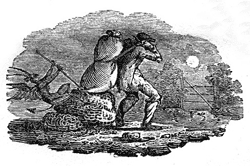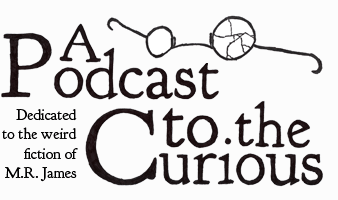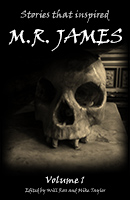 This episode we return to the diabolical doings of Mr Karswell in part two of our examination of ‘Casting the Runes’ by M.R. James.
This episode we return to the diabolical doings of Mr Karswell in part two of our examination of ‘Casting the Runes’ by M.R. James.
Show notes:
- Comparative Mythology and the Cambridge Ritualists (Wikipedia)
The criticism of Karswell’s writing style could be read as M.R. James having a dig at his academic contemporaries working in theoretical subjects that James thought were nonsense. For example see James’s ‘flaying’ of Jane Ellen Harrison (erratum: we incorrectly call her ‘Katherine Harrison’ in recording, sorry!). - The Golden Legend and The Golden Bough (Wikipedia)
The two very different texts which Mr Karswell is described as putting exactly on par and taking both as historical fact. - Thomas Bewick (1753-1826) (Wikipedia)
The “woodcut of Bewick’s” mentioned in Casting the Runes refers to English wood engraver Thomas Bewick, whose work varied between both studies of nature and the bawdy and macabre. For example a man followed by demons, a man urinating on a wall, and men riding gravestones. - The ‘Black Spot’ (Wikipedia)
James refers to the ‘black spot’ being put on John Harrington, a reference to Treasure Island (1883) by Robert Lewis Stevenson. - The Rime of the Ancient Mariner (Project Gutenberg)
The extract from the poem which Karswell sends to Harrington can be found in ‘Part the Sixth’ of Coleridge’s ‘Rime of the Ancient Mariner). - Lord Warden Hotel, Dover (www.dover-kent.co.uk)
Dunning and Harrington finish their adventure at a real hotel in Dover, the Lord Warden. The building is still there today, but no longer a hotel. - St. Vulfran’s Church, Abbeville, France (Wikipedia)
Karswell meets his death at a French church that M.R. James had visited on a previous holiday. The church is dedicated to St. Vulfran (or Wulfram) of Sens. Karswell’s death reminded us of the death of Adam Buxton’s character in Hot Fuzz (youtube – warning, it is gory!). - Casting the Runes (1979) (Irish Gothic Horror Journal)
An excellent review of the 1979 tv version of Casting the Runes. As mentioned in the podcast, we also didn’t rate it very highly but still recommend you purchase the dvd if only for the interesting extras that come on the disc. - Kate Bush/Night of the Demon mashup (Youtube)
The “it’s in the trees! It’s coming!” sample from the start of Kate Bush’s ‘Hounds of Love’ is a sample from Night of the Demon, the 1957 film of Casting the Runes. Thanks to @rodmckie for drawing our attention to this superb video mashup which combines footage from ‘Night of the Demon’ with various Kate Bush footage to great effect. - For more Casting the Runes-related links, see the show notes for part one.
Also! Robert Lloyd Parry was announced the next run of his excellent M.R. James stage performances between July and December 2012, including the world premier of his new show featuring ‘Count Magnus’ and ‘Number 13’! For more information visit the Nunkie Productions Website.
Podcast: Play in new window | Download
Subscribe: RSS
Tags: Black Spot, Casting the Runes, Class War, Comparative Mythology, Croydon, Dunning, Ghost Story, Golden Legend, Holden Bough, Horror, Jane Ellen Harrison, Karswell, London, Lord Warden Hotel, M.R. James, Night of the Demon, Thomas Bewick








Oh, in case any one doesn’t quite believe me about Croydon’s “mini Manhatten”: http://web.archive.org/web/20030529070308/http://www.croydonfilmcommission.com/index.asp?id=38. Sadly the Croydon Film Commission is no more.
That image of an non-human mouth under the pillow is by far one of the creepier things in that story! It’s so odd an image that it sticks with you. Was it part of the pillow or a wholly seperate thing sticking through it?
The worst part is I listened to that one in bed, with my damn hand under my pillow!
Thank You Thank You,this one is a particular favorite of mine. Very much looking forward to ” The Residence at Whitminster. Perhaps when you finish with james you might have a crack at some E.F. Benson.Really enjoying all the programs
Best Wishes Lachlan.
Oh Dear,that last post was supposed to be under “The Stalls of Barchester Cathedral”.
Slight glitch in the URL for the “man weeing a wall” woodcut (which I came here especially to see, heh). There’s a trailing space at the end that throws it off, but the URL should be http://www.fulltable.com/vts/aoi/b/bewick/v/18.jpg which takes you right to it. [if you click it, backspace the %20 away and no problems…and if it was only my browser that complained, then screw my browser for starting troubles…]
I’m a little behind and just catching up to your excellent podcast. You mentioned that runic magic is a more modern thing. But in that you are wrong, having been led to that thinking by associating the runes to Nordic runes. If you would look to Roman times, there was a huge tradition of “defixioners” (essentially hex-casters) who would use mystical figures and nonsensical glyphs (many of them patterned after Egyptian hieroglyphs) in casting curses. They would etch these glyphs on lead tablets and then leave them in or near the person they wanted to curse. For instance, in the stall of a racehorse they wanted to slow down or in the house of a man whose fortune’s someone wanted to reverse. I read about this in a Smithsonian article and then in the book Curse Tablets and Binding Spells of the Ancient World, John G. Gager, Oxford UP.
Yeah, in BBC/HBO’s “ROME” Servilia sits down, really mad, and “casts the runes” on Caesar and Octavians mother Atia, by scratching angry “lines” on some kind of black “greaseproof paper” while summoning all the gods of the underworld. Then she makes rolls of the papers and her slave puts the rolls in some cracks in a wall.
Whoops. Sorry. “fortunes” not “fortune’s.” Don’t know where that apostrophe came from.
I’ve listened to David Collings readings of James’s complete ghost stories at least 150-200 times (Hordern’s a little less) but never bothered to Read a full story, and then one can interpret things in cool (strange) ways. For example, the words that end this one, “But it was not long before Dunning stopped him” I always understood as being a quote of some of the words John Harrington said in his sleep before dying, which changes a notable part of the story, making it a bit brighter but still very good. You know, as if Henry Harrington doesn’t wanna dwell on this in Dunning’s presence because he thinks that if Dunning knows he’s going to “stop” Karswell before he’s done it, things might go wrong. You can imagine my surprise when I heard on your podcast the end sentence should really be spoken by the narrator…. It became more sinister, of course, but in any case the story is over at that point, so I think both “versions” are good, the real one darker (perhaps that’s better, this being horror) the “light” wrong interpretation a childrens version maybe? Ha ha…maybe not. Henrik Johnny Sunnerfors
Wow, and I thought I’d listened to the Collings readings a lot!
I only came across this site a month or so ago, so I’m playing catch-up. I’m currently re-reading or listening again to audio versions of James’ stories, and then following this up by listening to your very enjoyable accompanying podcasts.
As far as past adaptations of ‘Casting the Runes’ go, I was wondering if either of you guys were aware of this? It’s a preview for a now sadly, non-existing television adaptation.
http://www.youtube.com/watch?v=7v2OpMxYklQ
Hope it’s of some interest.
Welcome! Hope you are enjoying catching up. Let us know what you think. I hadn’t seen that before – looks like it would have been great, especially liked the adverts on the bus. Will tweet the link. Love that the video was posted by williamagar!
St Wulfran’s, in Abbeville, was a very popular site because of Ruskin’s writing about it. At the time the story is set (190-) Ruskin would have been widely read. I think Karswell’s visit shows that his interests were wider than just magic, and that this reinforces the idea that he is bitter about the snobbery of his detractors.
Another point, about the runes. My belief is that Karswell has summoned up a devil which will take him unless he can get someone else to divert its attention from him. Obviously he can’t openly recommend his pursuits to anyone else; so that getting them to accept the runes from him is a sort of symbolic way of doing it.
One of the few people to write about MRJ’s stories as literature is Mary Butts. She was once regarded as an important writer, but seems to have slipped out of fashion. In her essay (reprinted in “Warnings to the Curious”) she discusses “Casting the Runes” in some detail, but doesn’t mention the similarity between Karswell and Crowley. And yet she had been involved in research for one of Crowley’s books, and had later stayed with him but left in disgust at some of his practices. I wonder whether she genuinely saw no resemblance, or had edited Crowley out of her memories for some reason.
A few additional points.
Dunning, supposedly the leading authority etc, hasn’t heard of Harrington.
Karswell is an astute man, but fails to recognise Dunning without the beard.
If Karswell had received the telegram in time, and examined his ticket-case, what could he have done? Palmed off the runes on some hapless Frenchman?
It was just pointed out to me that “Night of the Demon” (a.k.a. “Curse of the Demon”) is included among the sci-fi and horror films referred to in the main title theme for “The Rocky Horror Picture Show”! I watched “Rocky Horror” many times in my misspent youth, but could never decipher that line!
Really disappointed at the casual transphobia, guys. “That’s not a girl” – REALLY? In a podcast in which you decry cheap 70s production values it’s pretty sad your politics are no more advanced.
Also – it’s Terry Gilliam, not Gillingham.
Have you guys seen this?
http://thehorrorsofitall.blogspot.com/search?q=james
I love to hear someone else’s take on these stories – the historical fill-ins are especially helpful. Here are a few thoughts after listening to these episodes:
First, while I generally stand fore-square against interpretations that extend beyond the text on the page, when I read the ‘mouth under the pillow’ bit, I couldn’t help but think of ‘vagina dentata’ – am I the only one?
https://en.wikipedia.org/wiki/Vagina_dentata
Next up, the rejection of Karswell’s manuscript. I would give the gentlemen the benefit of the doubt here. While I can allow for the plausibility of the ‘class warfare’ interpretation, I’d prefer to fall back to the simple answer – any editor will tell you that most submitted manuscripts are shit. I think it was Raymond Chandler who said that most novels are mediocre only because the vast majority, which are terrible, are never published. For me, part of the punch of the story comes from this interpretation. The character says that not only is Karswell’s grammar poor, but he actually believes his superstitious nonsense. And then we learn that the fool is no fool at all, and the rational men learn the hard way.
Finally, Dana (that’s Day-na) Andrews was a very successful actor through the 1940s-50s. His best known role was probably the as the detective in the noirish thriller Laura. Alcohol derailed his career, and he ended up doing Hollywood bit parts and television shows, including at least one Twilight Zone.
Excellent podcast. I am totally addicted to your podcast. I am listening to each and every of your podcast as I read weird fiction of MR James.
Thanks, great work!
(This podcast was released on May 10, 2012 and I am commenting it on May 10, 2019 🙂
Runes being used in divination is a modern idea not found in the original sources or in folklore, but there are several examples in Norse mythology and the sagas of runes being used to cause illness and curse people.
In ‘Skírnismál’ in the Poetic Edda, the god Freyr’s sends his messenger, Skírnir, who threatens to carve runes that will drive Gerðr insane with want and lust and give her no rest unless she agrees to Freyr’s proposal.
In ‘Egil’s Saga’ the titular protagonist Egill Skallagrímsson cures a girl who is bedridden when he finds a small piece of whale bone with runes carved on it; the runes were intended to be a love poem to make her fall in love with a young man who carved them and placed the piece of whale bone there, but instead it caused her serious illness because they were carved wrongly and acted like a curse rather than a love spell. Unless Egill had found the piece of whale bone with the accidental rune curse would have killed her.
There is also the Bergen rune-charm (B 257) which is intended to be used in love magic: https://en.wikipedia.org/wiki/Bergen_rune-charm
A níðstang, a wooden pole with runic inscription and a horsehead on top, is also used to curse someone – even to this day: https://en.wikipedia.org/wiki/Nithing_pole
Having re-listened to this episode now, I feel the need to defend the 1979 TV adaptation. As the story it takes place in the present day, rather than the vague thirty years ago setting James tended to use. But unlike the 1957 feature film the TV adaptation really makes the most out of the setting. Dunning works as a TV producer, and the exposé on Karswell is a hitpiece on TV. They also made Karswell an American, likely to give that sense of him being an outsider, as the possible class difference of the original story did. I also found the more ambiguous ending of the TV adaptation to be better than the 1957 feature film; the plane crashing seems more in line with the ending in James story than the in-your-face appearance of the demon, letting the audience imagine what must have happened onboard the plane. The out-of-focus view of the figure early on in the TV adaptation was also very well done, and it reminded me of Parkins’ dream in ‘Oh Whistle, and I’ll Come to You, My Lad’, where he sees “a figure in pale, fluttering draperies, ill-defined” moving in a strange manner. I also found the spider scene to be very effective, and a great way of translating the scene of Dunning feeling a face under his pillow to the screen.
I also thought Iain Cuthbertson was a great Karswell. Cuthbertson was also great in The Stone Tape (1972) & Children of the Stones (1976/7). Perhaps his fake American accent detracts from the performance somewhat, but I found his portrayal of Karswell to be more befitting the character of the story than the cheerful and talkative Karswell (played by Niall MacGinnis) in the 1957 film.
And the short adaptation of Mr Humphreys and His Inheritance included on the DVD is terrific IMHO. Despite its short runtime and low budget it manages to outshine anything by Gatiss.
I recently noticed that look of the demon in the 1957 film might be based on the engraving by Jean Duvet (1485–1561) of Christ on a white horse: https://www.metmuseum.org/art/collection/search/386240
In Duvet’s engraving the figure might be Satan himself, since it appears to be the main adversary of Christ in the scene.
My only real issue with the 1957 film, other than showing the demon too blatantly, is that it seems too much like a typical demon with horns you might see in Biblical illustrations. James tends to favour more unusual and original entities in his stories; as H. P. Lovecraft put it in Supernatural Horror in Literature: “the average James ghost is lean, dwarfish, and hairy – a sluggish, hellish night-abomination midway between beast and man”.